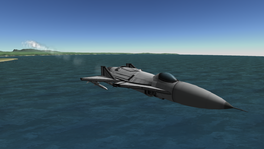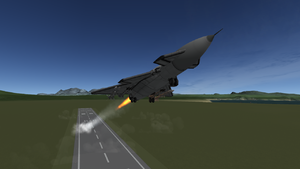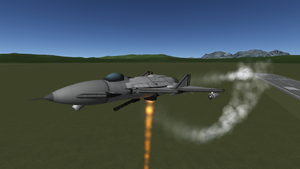F-34 Lightning
|
F-34 Lightning
|
|||||
|---|---|---|---|---|---|
| Role | Multirole Air Combat Fighter | ||||
| National Origin | {{{origin}}} | ||||
| Production History | |||||
| Service History | |||||
| Used By | OUAF (A), OUNN (B), ROKAF [Krome] (BIS/BIS2), RADF [Delras] (A) | ||||
The F-34 Lightning program- designed by the famed National Industries- was designed in the early 40's was designed as a be a multirole carrier VTOL/STOVL jet. After many years of service in the air force, it has proven to be great platform for all branches of service.
After sales to the Republic of Krome, the National Industries plant is working harder than ever to produce new variants- striving for perfection at every turn. After working for over 30 years, the design has been constantly tinkered and tested.
Development
With the dawn of the new decade, the Republic of Owlia's Air Force (ROAF) realized the need for a fighter platform capable of both land-based and carrier-based operations. It would need to be durable in combat, with small amounts of repair in between sorties; in the event of combat close to a carrier or airfield. The project- codenamed "X-30-" was wirst flown by United Aerospace on May 2nd, 2041. The prototype- X-30A21- was underpowered and failed to impress. The project underwent 2 more test flights before being taken over by National Industries on June 25th, 2041.
X-30A2 was built and flown on August 23rd. This protorype worked well with the ROAF requirements, and National Industries was awarded the contract for the new program.
Production for "A" models began in late 2041, with the first vehicles joining the ROAF in '42. "B" model production began in '41 as well, with the first plane arriving in '42.
As the years went by, the designs went fairly unchanged. In 2067, the Republic of Krome purchased 50 F-34BIS Stealth Carrier fighters- bolstering the force. The National Dynamics team found the chance to upgrade the platform- releasing the F-34BI2S in late 2069. This new interation of the F-34 program was sleeker, faster, lighter, stealthier, and cheaper- making it a good choice to exchange for the BIS1 model in the Kroman Armed Forces and the OUAF. Currently, the -34 is being upgraded by National Industries- likely to be either a BIS upgrade (The F-34BI3S) or an A model upgrade (F-34AS). The platform is constantly being upgraded, tinkered with, and updated by National Industries, and, as the companies motto says, "We're always striving for perfection."
Design
Naming
The F-34 line has a different naming scheme from other OUAF fighter lines. Here's a rundown of what letter means.
"F-": Designates the plane as a fighter.
"34": The number assigned to the plane from the manufacturer.
"B": It's the B line. All lines have the same purpose and same general design.
"I": Ancient numerals. This means it is the first type of F-34B.
"#": The amount of revisions the plane has gone through. (Ex. F-34BI4 means that it is the fourth revision.)
"S": Optional suffix. This means that the plane is a stealth version.
- A
The F-34A Lightning is a single-engine fighter with no VTOL or carrier abilities. The main wing is set at a slightly swept angle that marginally reduces RCS-also giving it the signature shape of all F-34s. The fighter is meant mainly for conventional or shortened/improvised runways with its durable undercarriage. To enhance maneuverability, a middle "wing" and front canards are sat smoothly into the frame- a feature that was removed in plans for the F-34A2 but never put into effect.
- B
The F-34B models are multirole combat jets with a single VTOL engine and a single horizontal "Main" engine. The models have the same shape and design as "A" models, but have various packages (See "Variants" for more). The "B" variants are meant mainly for carrier operations, but can be used from air strips and conventional runways as well.
History
The F-34 program is one of the most extensive and well-funded programs in the Owlian Armed Forces.The fighters have been heavily used in combat and patrols- first serving to protect the retreat of Republican ships in the Republic War before serving to protect the Owlian Airspace during the Fish War. F-34A's were used to patrol and enforce the 75km no-fly-zone (Which wasn't breached), while F-34B's sailed on carriers in case of a breach. After a few years, F-34's were back at the front of combat in the Delras Conflict. F-34BII fighters gained fame after the Battle of Delsden- destroying DCR carriers and ships, while F-34BI fighters engaged F-12B fighters in a high-stakes aerial battle.
In 2067, the Republic of Krome purchased 50 F-35BIS fighter jets, which were later exchanged for F-34BI2S fighter jets in 2069.
Variants
Current Variants
X-30/X-30B
Concept Prototype. The X-30B was the first ROAF plane with Fly-by-Wire control.
F-34A Lightning
Standard F-34 model with an anti-air package. Remains largely unchanged from its initial design.
F-34B Lightning
VTOL variant of the F-34. Multiple versions and types allow the platform to work for many purposes.
F-34BI
Air-to-Air type
F-34BIS
Stealth variant of the F-34BI
F-34BI2S
Enhanced model of the F-34BIS
F-34BII
Strike package of the F-34B complete with Air-to-Ground Missiles, a downward-facing 20mm turret, and rocket pods for anti-ship operations.
F-34BIIS
Stealth variant of the F-34BII
Planned Variants
As of 2070, there are no new variants planned by either the OUAF, OUNN, or Rivera Dynamics.
Losses
Over the course of the F-34 program, 1 plane has been shot down, 2 have crashe, and multiple were lost to early technical issues.
- In the Delras Conflict, one F-34BI fighter was shot down during the Delsden Naval Battle. The pilot was recovered after the battle, but the plane was lost.
- On landing, an F-34A was lost due to navigational systems failure. The plane- Tail Number 56-0120- crashed into the ground and killed the pilot. April 3rd, 2043.
- In International Aerospace testing, an X-30B test resulted in the plane flipping over on a VTO (Vertical Takeoff) test. The pilot escaped with a broken collarbone and fractured hand. June 1st, 2041.
- Multiple other losses were atributed to general wear; older "B" models had issues with moisture seeping into the Fly-by-wire and Control Electronics. This issues was rectified by 2044.


